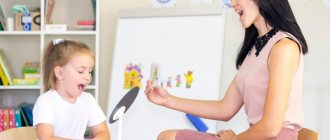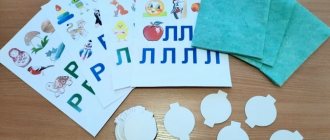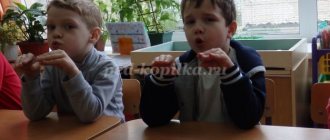The main forms of organizing work with children with speech impairments at the speech therapy center of a preschool educational institution are individual, subgroup classes and classes in small groups.
The predominant form of correctional work in the preschool educational institution’s speech center is individual lessons, because the use of this form of work allows you to successfully establish contact and understanding between the speech therapist and the child. The duration and frequency of individual lessons is determined by a specialist and depends on the severity of disorders of the articulatory apparatus and delays in speech development. Typically, individual lessons last no more than 20 minutes and are held twice a week.
The main goal of an individual lesson is: selection of complex exercises aimed at eliminating specific disorders of the sound side of speech.
Objectives of an individual lesson
| Educational objectives | Formation of the concept of the mechanism of sound formation and its acoustic features; formation or consolidation of knowledge about a syllable, a word, a sentence; consolidation of the dictionary or clarification of words containing a given sound on a lexical topic (this could be “Toys”, “Autumn”, “Shoes”, etc.) |
| Corrective tasks | Development and improvement of articulatory motor skills; formation of rules for oral exhalation taking into account this phoneme; development of phonemic hearing and voice; formation of conditioned reflex connections to a given articulatory-acoustic image |
| Educational tasks | Correction of the child’s personality as a whole. |
Below, I would like to present to you, dear colleagues, the structure of an individual lesson.
Designing a speech therapy lesson in accordance with the requirements of the Federal State Educational Standard for Educational Education
Designing a speech therapy lesson
in accordance with the requirements of the Federal State Educational Standard in preschool educational institutions.
Teacher speech therapist:
Seregina T.G.
.
The specificity of preschool age is such that the achievements of preschool children are determined not by the sum of specific knowledge, abilities and skills, but by a set of personal qualities, including those that ensure the child’s psychological readiness for school.
The Federal State Educational Standard puts at the forefront an individual approach to the child and play, where the intrinsic value of preschool childhood is preserved and where the very nature of the preschooler is preserved. The leading types of children's activities will be: gaming, communicative, motor, cognitive-research, productive, etc.
It should be noted that educational activities are carried out throughout the entire time the child is in the preschool organization.
These are: joint (partnership) activities of the teacher and children:
educational activities in special moments;
organized educational activities;
independent activity of children.
Organized educational activity is the organization of joint activities between a teacher and children:
with one child;
with a subgroup of children;
with a whole group of children.
The choice of the number of children depends on:
age and individual characteristics of children;
type of activity (game, cognitive - research, motor,
productive);
their interest in this activity;
complexity of the material.
But it must be remembered that every child should receive the same
starting opportunities for schooling.
The main feature of the organization of educational activities in preschool educational institutions at the present stage is the departure from educational activities (classes), increasing the status of play as the main activity of preschool children; inclusion in the process of effective forms of work with children: ICT, project activities, gaming, problem-based learning situations as part of the integration of educational areas.
Thus, “class” as a specially organized form of educational
Kindergarten activities are cancelled. The activity should be a specific children's activity that is interesting for children, specially organized by the teacher, implying their activity, business interaction and communication, the accumulation by children of certain information about the world around them, the formation of certain knowledge, skills and abilities. But the learning process remains. Teachers continue to “work” with children. Meanwhile, it is necessary to understand the difference between “old” learning and “new” learning.
If previously organized educational activities were carried out in the form of educational activities, then modern standards suggest teaching children through the organization of children's activities.
When designing corrective classes, the speech therapist must take into account the following important features of modern preschool education, which differ from traditional education:
A child and an adult are both subjects of interaction. They are equal in importance.
Each is equally valuable. Although an adult, of course, is older and more experienced.
The activity of a child is at least no less than the activity of an adult.
The main activities are the so-called children's activities. The goal is the genuine activity (activity) of children, and the development of knowledge, skills and abilities is a side effect of this activity.
The main model of organizing the educational process is the joint activity of an adult and a child.
The main forms of working with children are examination, observations, conversations,
talking, experimenting, research, collecting, reading, doing projects, etc.
Mainly so-called indirect teaching methods are used (with partial use of direct ones).
The motives for learning, carried out as the organization of children's activities, are primarily related to the children's interest in these types of activities.
The main goal of the teacher in the lesson is to form and support the child’s initiative in perceiving new information, searching and processing information, generalizing methods of action, setting an educational task, etc.
So-called free attendance of classes is allowed. Respecting the child, his condition, mood, preferences and interests, the adult is obliged to provide him with the opportunity to choose - to participate or not to participate with other children in a joint business, but at the same time has the right to demand the same respect for the participants in this joint business.
The educational process involves making changes (adjustments) to plans, programs taking into account the needs and interests of children; notes can be used partially to borrow factual material (for example, interesting information about composers, writers, artists and their works), individual methods and techniques, etc. ., but not as a “ready-made example” of the educational process.
Structure of a speech therapy lesson.
Organizing time.
It takes place in the form of preparation for the game (children prepare what they will need during the lesson, under the guidance of adults), they tune in to the game, and do not calm down.
2. Development of visual perception and visual memory.
It takes place in the form of a game, the game material is selected taking into account the individual level of development of each child.
3. Development of visual-spatial orientation:
– development of general motor skills. It takes place in the form of a dynamic pause, without interrupting the gameplay, but before or after it, to change activities.
– development of fine motor skills. There is a choice of using pentagonal pencils, balls, clothespins, rubber bands, cubes, etc.
4. Development of auditory perception, auditory attention, auditory memory.
Provide children with the opportunity to put forward their own assumptions, learn to prove their point of view, form adequate self-esteem, and evaluate their actions, without, for example, identifying one unsuccessful assumption with their own assessment as a whole.
5. Development of articulatory motor skills.
It is necessary to explain not only the technique of performing each exercise, but also the meaning, the meaning of each movement of the organs of the articulatory apparatus, so that the child does not just automatically perform all the exercises, but understands why he is doing each specific movement.
6. Development of breathing and voice.
During exercises performed to develop breathing, the teacher does not show how to perform the exercise, but performs the exercises together with the children, since in the educational process the teacher and students are partners.
7. Announcement of the topic.
It is not the teacher who announces the topic, but the children make assumptions after joint consideration, observation, conversation, conversation, experimentation, research, comparison, generalization (the teacher leads them to this), thereby creating motivation to learn new things. Any assumption of children deserves attention, and not a single hypothesis that is incorrect, in our opinion, should be sharply refuted, thereby humiliating the child and convincing him of his own inferiority. It is necessary to help the student change his point of view through his own logical conclusions.
8. Development of phonemic hearing.
The course of the lesson is accompanied by significant speech practice of the students, which involves communication with teachers and children on equal terms.
9. Work on syllable structure, sound analysis of syllables.
Always accompanied by a visual image, since it is impossible to clearly and correctly reproduce the sound composition of a word without knowing its meaning and not
presenting a visual image.
10. Summary of the lesson.
Summing up the results of the lesson is focused on the formation of adequate self-esteem, assessment of one’s activities and a positive attitude towards the world.
11. Assessing children’s work in class.
What is assessed is not the children’s activity in the lesson, but the extent to which the lesson material helped the children clarify and enrich their knowledge.
Thus, it is clear that the entire system of organizing and conducting
classes. And in connection with this, the image of the teacher must change. The teacher communicates with children on equal terms, his appearance must correspond to the children’s acceptance, that is, in order for the children to accept him as “one of their own,” he must easily enter into cooperation with children at their level.
The structure of an individual lesson at the stage of sound production
- Organizing time
- Articulation exercises: general articulation exercises, special articulation exercises, exercises to develop the strength of the voice and exhalation.
- Announcing the topic of the lesson to the child.
- Sound production (by imitation, from a preserved phoneme, from articulation exercises, by mechanical influence).
- Analysis of articulation according to plan: position of the lips, position of the teeth, position of the tongue (tip, back, root), participation of the vocal folds, nature of the exhaled stream.
- Consolidating isolated sound: pronunciation, onomatopoeia games.
- Development of phonemic hearing: sound recognition in a series of isolated sounds, distant in articulatory and acoustic characteristics, in syllables, taking into account the above recommendations, in words, in sentences, in text.
- Consolidating the pronunciation of sounds in words.
- Homework.
- Result of the lesson: repetition of which sound was practiced during the lesson, analysis of the main provisions of the articulation of the sound being studied, final pronunciation.
- Assessment of a child’s work in class is carried out with a positive psychological focus.
And in conclusion, I would like to note that when preparing and conducting an individual lesson, it is very important to remember that throughout the entire lesson the child must maintain a strong positive emotional attitude, which is expressed in the desire to study. This is achieved by using surprise moments, game fragments, exciting tasks and exercises, during which the learning process turns into an interesting game.
The structure of a speech therapy lesson; educational and methodological material on speech therapy on the topic
Structure of individual-subgroup classes:
Objectives: 1. General didactic.
2. Correctional speech and correctional non-speech (CSF).
- Educational.
Progress of the lesson:
- Org. moment. Correction of HMF (carried out during each task, at each stage of the lesson), emotional and personal characteristics, behavior. Psycho-gymnastics.
- Relaxation, normalization of tone, massage.
- Articulation gymnastics.
- Mimic exercises.
- Breathing exercises, formation of an air stream (tasks may precede articulation gymnastics).
- Voice exercises.
- Practicing reference sounds.
- Staging, sound correction. Characteristics of sound based on acoustic and motor characteristics.
- Development of speech hearing, phonemic hearing, phonemic perception (tasks may precede articulation exercises, production of sounds, if the primary sensory impairment is).
- Automation (differentiation) of sound:
a) in syllables // sound-syllable analysis and synthesis // correction of the syllabic structure of the word // correction of prosody (tempo-rhythmic, intonation-melodic design of the utterance and diction) // correction of the VMF;
b) in words // repetition or introduction of new tasks for automation (differentiation) in syllables // sound-syllabic analysis and synthesis // correction of syllable structure // correction of prosody // formation of lexico-grammatical categories // correction of VPF;
c) in phrases, texts // repetition or introduction of new tasks for automation (differentiation) in words (phrases) // language analysis and synthesis // correction of syllable structure // correction of prosody // formation of lexical and grammatical categories // development of coherent speech // VPF correction;
- Development of general motor skills, fine motor skills (physical training can be carried out several times during the lesson, as needed).
- Getting to know the letter, working with the cash register, reading.
- Graphic exercises.
- Summary of the lesson.
Symbol: // - work is carried out in parallel. Note: some stages are included in the lesson at the discretion of the speech therapist, depending on the goals of the lesson, the period of training, and the child’s capabilities.
Approximate structure of frontal classes on pronunciation and literacy:
Goals:
- General didactic.
- Corrective speech and correctional non-speech (CSF).
- Educational.
Progress of the lesson:
- Org moment.
- Characteristics of sound based on acoustic and motor characteristics. Isolated sound pronunciation. Phonorhythmics.
- Correction of auditory attention, phonemic hearing. Isolation of sound by ear.
- Pronunciation of sound in syllables // Pronunciation of sound in words // Pronunciation of sound in a phrase // Pronunciation of sound in text // Correction of the syllabic structure of a word // Correction of prosody (tempo-rhythmic, intonation-melodic design of a statement and diction) // Consolidation exercises lexical and grammatical categories available to children.
- Physical exercise.
- Development of phonemic awareness. Sound analysis and synthesis.
- Introducing the letter.
- Working with the cash register. Laying out syllables and words following sound analysis.
- Reading.
- Graphic exercises. Typing letters, syllables, words, sentences.
- Summary of the lesson.
Methodological recommendations for conducting frontal pronunciation classes:
— classes are structured taking into account the tasks and content of each training period;
- lexical material should be saturated with the sound being studied;
- the lesson is based on sounds correctly pronounced by the child, mixed, defectively pronounced sounds are excluded;
- lexical material should be varied: syllables, words, sentences, texts;
- the sound being studied must be in different phonetic positions: at the beginning, middle, end of the word;
— the content of the lesson should be a system of exercises to consolidate the sound being studied;
- lexical material should consist of words with a syllabic structure accessible to the child;
— exercises to develop phonemic hearing and perception are given in order of increasing complexity;
— tasks to prepare children for sound analysis and synthesis are intertwined with exercises to master the elements of literacy.
— exercises to consolidate the lexical and grammatical categories existing in children are given on the material of correctly pronounced sounds;
— depending on the period of study, exercises are included to develop coherent speech based on correctly pronounced sounds;
— it is mandatory to include tasks for the development of auditory-speech, visual memory, attention, exercises for the development of mental activity;
- physical training can be carried out several times during the lesson, as needed.
Structure of frontal lessons on the formation of lexical and grammatical categories and the development of coherent speech:
- Introductory class.
- Organizational moment (1-2 minutes).
- Introduction to the topic.
- Activation of existing knowledge (15-20 minutes)
- Fizminutka (correction of general and fine motor skills).
- The outcome of the lesson (can be meaningful (what did you do, what did you like?), evaluative (how did you do it?), activity-based (check whether the goals were achieved), game-based (finish the lesson on a positive emotional background).
- A lesson on learning new material.
- Org moment.
- Repeat (5-6 minutes).
- Studying new material (7-10 minutes).
- Physical exercise.
- Summarizing the material studied (5 minutes).
- Consolidation of the studied material (5 minutes).
- Summary of the lesson.
- A general lesson.
- Org moment.
- Introduction to the topic.
- Generalization, systematization of knowledge.
- Physical exercise.
- Summary of the lesson.
- Combined classes.
Methodological recommendations for conducting classes on the formation of lexical and grammatical categories and the development of coherent speech:
— determine the topic and goals of the lesson;
- highlight a subject, verb dictionary, and a dictionary of signs that children must learn in active speech;
— when selecting lexical material, non-standardized phonetic formatting of part of the speech material is allowed;
— identify the main stages of the lesson, showing their interrelation and interdependence;
— formulate the task of each stage;
- ensure gradual complication of speech and speech-thinking tasks;
- include in classes a variety of game and didactic exercises with elements of competition, control over one’s actions and the actions (responses) of a friend;
— provide techniques that ensure the activation of cognitive activity and motor activity;
— provide for a change in methodological techniques;
- include regular repetition of speech material in the lesson;
— think over a clear system of questions addressed to children;
— identify children who need to be involved at a specific stage;
- observe a strict time-saving regime, calculate the amount of time required for each exercise;
— think through different options for correcting errors;
- allocate time for physical exercises;
— distribute emotional moments in such a way that the most interesting fragments of work are related to the period of increasing fatigue;
— visibility should be widely presented (theater, toys, natural objects, pictures, symbols);
— manuals must be colorful, aesthetically designed, of sufficient size (demonstration and visual material), accessible to understanding;
- pay attention to the behavior, facial expressions, tone, and nature of speech activity of the speech therapist himself;
— the speech therapist’s instructions must be precise, concise, and understandable; speech – moderately emotional;
— in a speech therapy session, children’s speech should prevail.




